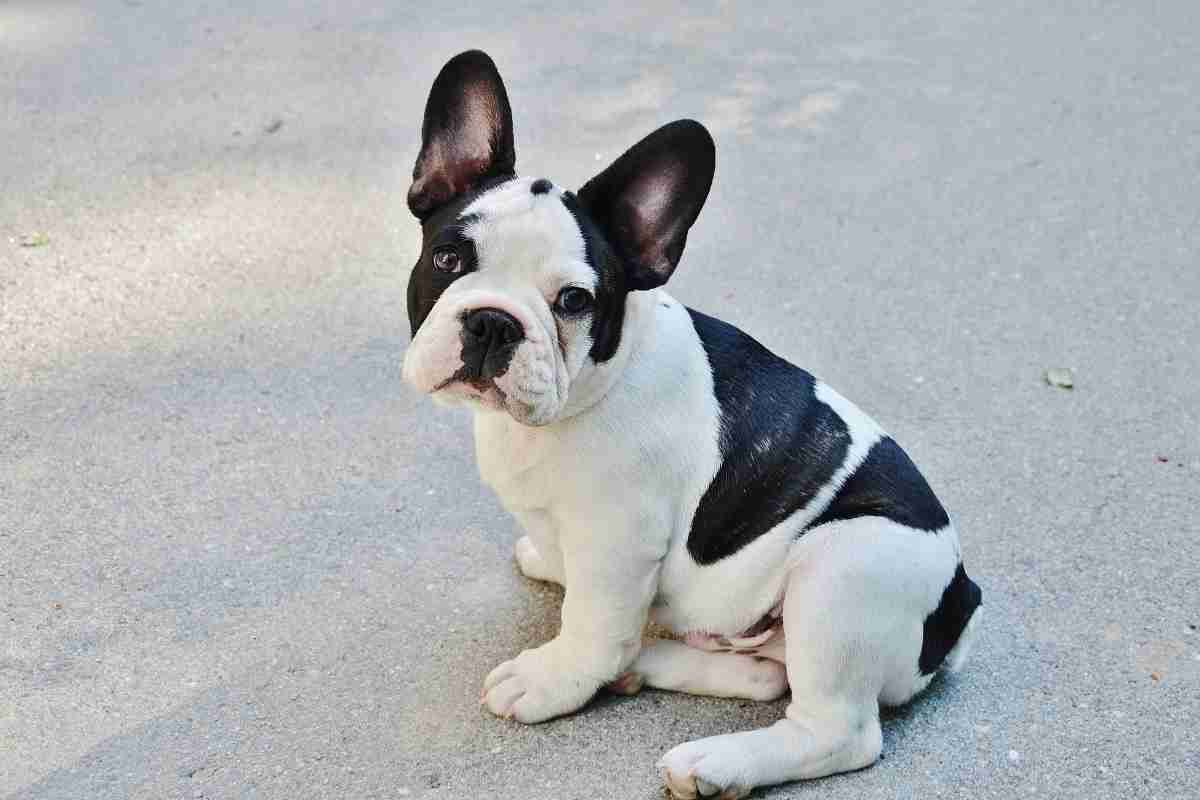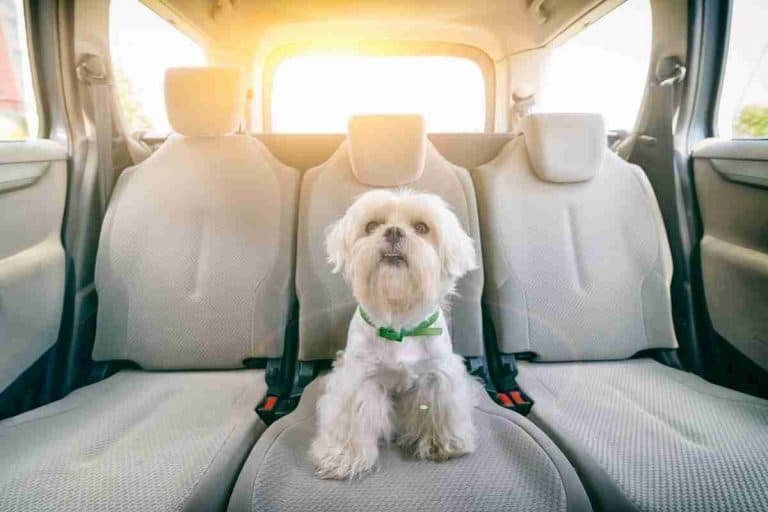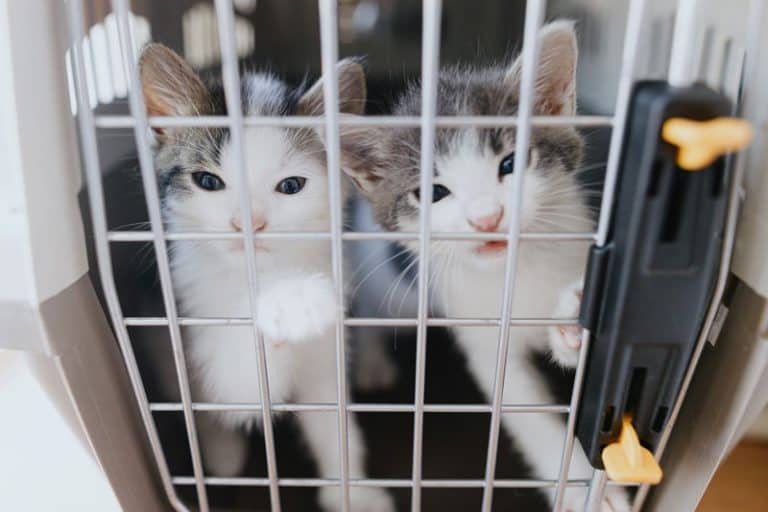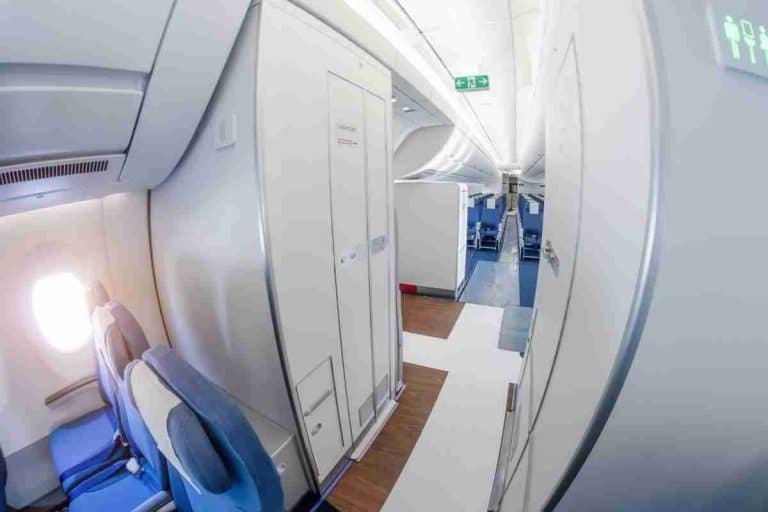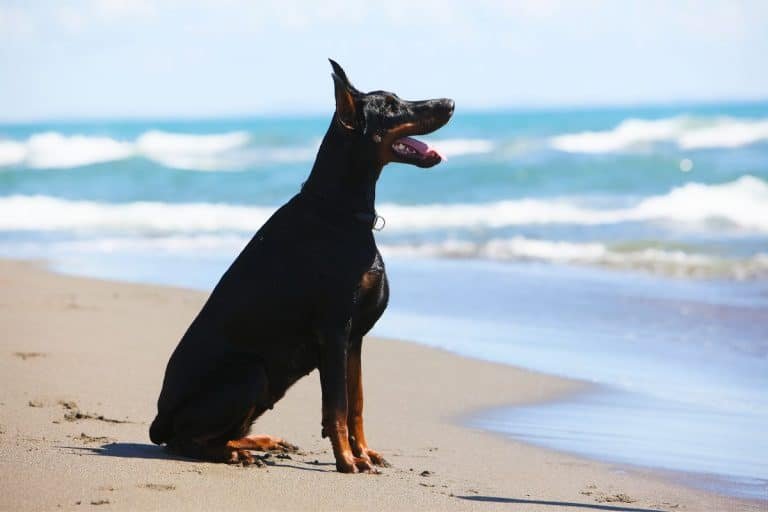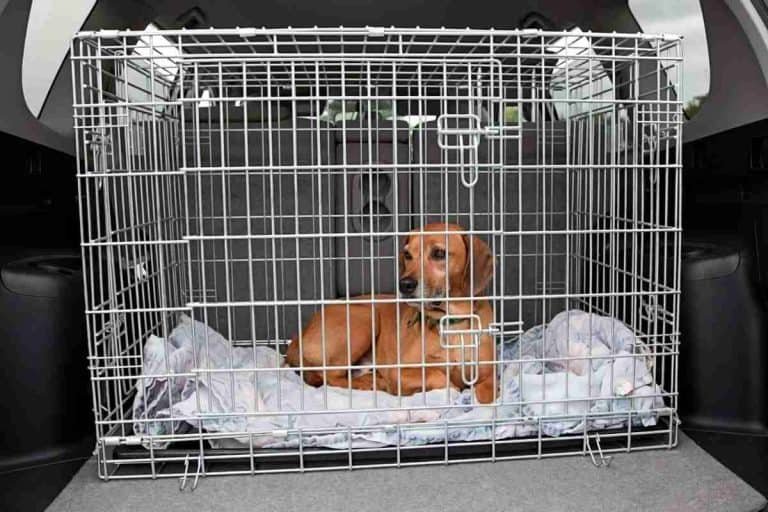8 Airlines That Allow Snub-Nosed Dogs in Cabin (Full List & Prices)
Last Updated on September 7, 2025
Flying with a pug or French Bulldog often proves confusing. Policies shift by carrier, aircraft, and route. This guide lists 8 airlines that allow snub-nosed dogs in cabin, with the full list and prices. It compares in‑cabin pet fees, carrier dimensions, weight limits, and booking rules. It also flags cargo bans, seasonal heat restrictions, and route exceptions that affect brachycephalic breeds.
Owners will find practical prep as well. Expect a pre‑flight checklist, vet and paperwork timing, and airport‑to‑in‑flight tips. Sections cover carrier selection, distress signs, and crew communication. International rules, safer alternatives, and FAQs complete the picture. The following sections help travelers choose the right airline and avoid last‑minute refusals.
Airlines that permit snub-nosed dogs — the 8 carriers
Delta Air Lines
In-cabin allowed / cargo banned for brachycephalic breeds
Delta permits brachycephalic (snub-nosed) dogs in the cabin when they meet in-cabin carrier requirements. Delta prohibits these breeds in checked or manifest cargo on most flights because of increased respiratory risks. Always confirm the aircraft type, since some route exceptions apply.
Typical pet fee and booking notes
Expect a standard in-cabin pet fee, payable at booking or check-in. Delta strongly recommends advance reservations; in-cabin space fills quickly. Passengers should present carrier dimensions and any medical documentation at the gate when requested.
Carrier size, weight guidance and common route exceptions
Delta requires a soft-sided carrier that fits under the seat. Combined pet-plus-carrier weight limits vary by aircraft; measure carefully. For related cargo policies see airlines that allow dogs in the cargo area.
United Airlines
In-cabin rules and cargo restrictions
United allows snub-nosed dogs in cabin carriers that fit beneath the seat. United restricts brachycephalic breeds from cargo compartments on most flights. Routes to and from specific destinations sometimes carry tighter rules.
Fee range and advance reservation tips
Fees vary by route; United charges a per-flight in-cabin fee. Book the pet early and reconfirm at check-in. Documentation of current vaccinations may be requested for certain international legs.
Carrier dimensions and seat/aircraft considerations
United enforces carrier size limits per aircraft; bulkhead rows and exit rows can complicate placement. For breed-size fit guidance, consult resources like airlines that allow large dogs in cabin for carrier and seat-fit tips.
American Airlines
What’s allowed in cabin and banned in cargo
American permits snub-nosed dogs in the cabin when they remain inside approved carriers. Brachycephalic breeds frequently face cargo bans due to respiratory risk. Confirm whether a specific connection involves a partner carrier with different rules.
Pricing, pet count limits and booking window
American charges per pet, per flight, with limits on how many pets travel in-cabin per flight. Booking early avoids disappointment; some aircraft accept only a few in-cabin pets. Agents may refuse pets at gate if space limits are reached.
Carrier types accepted and enforcement notes
Only soft-sided carriers that fit under the seat get accepted. Gate staff may check the carrier to ensure the pet remains inside. See practical sizing guidance at dog breeds that fit under airplane seat.
JetBlue
In-cabin only policy, carrier size limits and weight guidance
JetBlue allows snub-nosed dogs only in-cabin inside compliant carriers. The carrier must fit under the seat in front and fasten closed. Weight guidance varies; measure combined pet and carrier to ensure compliance.
Typical cost and sticker checks at gate
JetBlue charges a set in-cabin pet fee per flight. Gate agents often perform a quick sticker or carrier check during boarding. If the carrier looks unsafe or the pet appears unwell, staff may refuse transport.
Practical tips for boarding with JetBlue
Arrive early to secure overhead and under-seat space. Label the carrier, carry vaccination records, and calm the pet before boarding. For behavior-related policies, consult resources such as what happens if my dog barks on a plane.
Alaska Airlines
In-cabin allowance, carrier dimensions and common exceptions
Alaska permits brachycephalic dogs in-cabin when the carrier fits beneath the seat. Some smaller regional aircraft impose tighter carrier-size limits. Alaska may restrict pets on specific seasonal or high-heat routes.
Fees and how Alaska handles connecting flights
Alaska charges an in-cabin fee per flight segment. For itineraries with partners or connections, verify pet allowances on every carrier. Booking a single-reservation itinerary reduces surprises and rebooking needs.
Gate-agent and aircraft-specific tips
Gate agents inspect carriers for secure closures. If the pet appears stressed, agents may request a vet note. For broader travel preparation and gear, see essential dog travel tips and gear for road trips.
Air Canada
In-cabin policies, soft-sided carrier requirement and cargo ban
Air Canada requires soft-sided carriers for in-cabin travel and generally bans brachycephalic breeds from cargo. Carriers must fit under the seat and provide adequate ventilation. Seasonal restrictions tighten during hot months.
Fees, reservation requirements and seasonal rules
Fees vary by route; passengers must reserve in-cabin space in advance. Air Canada may suspend pet bookings on high-heat days or on specific aircraft types for safety reasons. Confirm reservations close to departure.
Documentation needed for cross-border travel with Air Canada
International travel demands health certificates, proof of vaccinations, and sometimes import permits. For handling small-animal logistics on flights, reference tips like those found at flying with two cats on a plane.
KLM (example European carrier)
Combined pet+carrier weight limits and in-cabin restrictions
KLM sets combined pet-and-carrier weight limits for in-cabin travel and restricts certain breeds from cargo. Intra-Europe rules vary by country, so check both airline and destination regulations before travel.
Typical fees, advance booking and intra-Europe rules
KLM charges in-cabin fees and requires advance reservation. Some regional flights enforce stricter carrier dimensions. For European connections, travelers must confirm acceptance by any operating or codeshare carrier.
Cargo prohibition for brachycephalic breeds and size guidance
KLM generally prohibits snub-nosed breeds in cargo for welfare. For sizing and carrier advice on small-breed travel, consult European-focused airline resources like airlines that allow cats in cabin.
Aeroméxico (example Latin American carrier)
In-cabin allowance, combined weight limit and carrier rules
Aeroméxico permits snub-nosed dogs in the cabin when carriers meet size rules and combined weight limits. Soft-sided carriers that fit under the seat remain the standard requirement on most routes.
Fees, ESA/service animal notes and route exceptions
Fees apply per flight segment. Aeroméxico treats service animals differently; documentation rules can be strict. Some long-haul or seasonal routes disallow in-cabin pets for safety reasons.
When Aeroméxico will refuse transport (seasonal/route notes)
Aeroméxico may refuse transport during extreme heat, on certain high-altitude routes, or when aircraft limitations exist. Always reconfirm pet acceptance at booking and again before departure. For broader travel alternatives, see traveling with your dog by train tips and tricks.
Why many airlines limit or ban flat-faced breeds
Airlines restrict or ban brachycephalic breeds because data and veterinary guidance show elevated in‑flight risk. Flat‑faced dogs carry anatomical traits that make them prone to respiratory collapse during transport. When an animal suffers distress at altitude or during handling, airlines face liability, potential flight disruptions, and public backlash. Carriers balance animal welfare, crew safety, and operational risk when crafting policy.
Policies also reflect practical constraints. Cabin space under seats limits movement and airflow for bulky or poorly fitting carriers. Cargo holds expose sensitive breeds to temperature swings and delayed veterinary care. Given those variables, many airlines limit certain breeds, require health certificates, or forbid travel during hot months.
Travelers should review individual carrier rules before booking and consider alternatives such as direct flights, pet relocation services, or ground travel for high‑risk dogs. For more on how some airlines handle dogs outside the cabin, see airlines that allow dogs in the cargo.
How brachycephalic anatomy raises in-flight risk
Brachycephalic dogs have shortened skulls and compressed airways. Stenotic nares, an elongated soft palate, and a relatively small trachea reduce airflow at baseline. Those traits increase resistance to breathing and raise the risk of hypoxia when the body faces added stressors.
Cabin pressurization lowers available oxygen slightly compared with sea level. Combined with travel stress, heat, and excitement, even small reductions in oxygen or increased airway resistance can trigger pronounced respiratory effort. Heat dissipation also suffers; panting becomes less effective when upper airway structures obstruct airflow.
Sedatives and tranquilizers further complicate risk. Drugs that depress respiration or blunt thermoregulation can tip a vulnerable dog into crisis. Veterinarians generally advise caution with sedatives for brachycephalic patients, and many airlines require a recent health certificate noting fitness to fly. For practical guidance on flight‑related ear and pressure issues, see does flying hurt dogs’ ears.
Differences between cabin and cargo environments
The cabin and cargo hold present very different environments. The cabin offers stable climate control, immediate access to the owner, and the possibility of constant monitoring. However, space under the seat limits carrier size and airflow, and turbulence can jostle even well‑secured pets.
By contrast, the cargo area exposes animals to more noise, vibration, and handling during loading and unloading. Temperature control in the hold can vary by aircraft model, and access to the animal is impossible during flight. For brachycephalic breeds, delayed response to a developing respiratory emergency creates a major welfare concern.
Crate design and airline handling standards matter. A well‑ventilated, airline‑approved crate reduces risk in cargo, but it cannot replicate the constant oversight an owner provides in the cabin. For tips on securing an animal in a vehicle cargo area — useful background on confinement and comfort — see how to secure a dog in the cargo area of an SUV.
Seasonal, aircraft type and route-based risk factors
Seasonality strongly affects safety for snub‑nosed breeds. Heat waves raise mortality risk in summer; cold snaps can also stress animals unaccustomed to low temperatures. Many airlines issue seasonal embargoes for pets on hot days or during extreme cold.
Aircraft type and configuration influence environmental stability. Modern widebodies and newer narrowbodies typically maintain more consistent temperature and pressure control than older regional turboprops. Long‑haul flights increase cumulative stress from handling, multiple loading events, and longer time away from veterinary care. Nonstop routes reduce handling and exposure; itineraries with layovers amplify risk.
Route geography matters too. Flights over remote areas or to airports with limited onsite veterinary care heighten the consequences of an emergency. Travelers should check airline seasonal restrictions, aircraft model for the booked flight, and route specifics before purchase. When unsure, consult the carrier and a veterinarian for a fitness‑to‑fly certificate and consider alternate transport. For information on carriers that permit larger pets in cabin spaces, see airlines that allow large dogs in cabin.
Pre-flight checklist for snub-nosed dogs

Mandatory vet exam, health certificates and timing for paperwork
Schedule a vet exam at least 7–14 days before the flight. The veterinarian should verify vaccination records and assess breathing risk typical of brachycephalic breeds. Obtain any required health certificates and, if traveling internationally, check country-specific entry rules. Keep digital and printed copies of all documents accessible at check-in.
Booking: reserving pet spots, notifying airlines and seat selection
Reserve the pet spot immediately after booking the human seats. Many carriers cap in-cabin pets and close reservations early. Notify the airline about a snub-nosed dog and request a forward cabin seat if possible for better ventilation and crew access. Confirm fees and documentation at least 72 hours before departure.
Crate & carrier sizing: soft vs hard and ventilation priorities
Choose a carrier that meets airline size limits and allows the dog to stand and turn. Prioritize models with rigid ventilation on three sides for consistent airflow. Soft-sided bags work for under-seat stowage, but a well-ventilated hard carrier reduces crush risk. For more general gear guidance, see essential dog travel tips and gear for road trips.
Training, desensitization and exercise in the days before travel
Introduce the carrier gradually with short, positive sessions. Increase duration to mimic flight time. Practice crate entries and quiet waiting periods. Give a calm, moderate exercise session on travel day to reduce excess panting and stress. Avoid overexertion, which can worsen breathing issues.
Feeding, hydration, cooling strategies and medication guidance
Feed a light meal 3–4 hours before departure and offer water up to boarding. Use cooling pads or breathable liners when temperatures rise. Discuss sedatives and anti-anxiety options with the vet; many professionals advise against heavy sedation for brachycephalic dogs. Book a vet consult as needed and re-confirm on the day of travel.
Airport, boarding and in-flight best practices
Owners should prepare each step with snub-nosed dogs’ extra respiratory risk in mind. Book direct flights and daytime schedules to avoid extreme temperatures in terminals. Choose airlines and flights with consistent under-seat dimensions; measure both carrier and the airline’s stated allowance. Keep the dog rested the day before travel and avoid heavy exercise within four hours of departure to reduce panting risk.
Pack a compact travel kit: a properly sized soft-sided carrier, absorbent pads, an extra leash, bottled water in a spill-proof bottle, and a veterinary health letter describing the breed’s known risks. Pre-flight acclimation to the carrier eases anxiety and lowers in-cabin stress. Confirm the airline’s temperature and breed restrictions, and reserve the pet slot early—many carriers limit brachycephalic breeds per flight. For broader preparation checklists and gear recommendations, see essential dog travel tips and gear for road trips.
Check-in, gate procedures and what to show staff
At check-in, present proof of current vaccinations and a recent veterinary health certificate. Airlines commonly require a written letter from the veterinarian stating the dog is fit to fly and noting brachycephalic status. Arrive 90 minutes early for domestic flights and two hours for international departures to allow time for extra screening and paperwork verification.
Keep documents in an accessible folder and show them proactively to the agent. If the dog has a sedative or medication, disclose it and carry a prescription note. Verify carrier dimensions at the counter and ask staff to confirm the pet’s under-seat location. If security requests removal from the carrier for inspection, request a private screening; maintain control of the dog on a short leash. For policy examples and similar cabin-pet rules, consult airlines that allow cats in cabin.
How to work with gate agents and flight attendants (calm, clear requests)
Approach gate agents and flight attendants with concise, calm requests. State the dog’s breed and any immediate needs—temperature sensitivity, need for additional airflow, or medication times. Hand over documentation quickly and summarize key facts: last vet check date, recent symptoms, and emergency contact. Clear communication reduces delays and builds crew confidence.
Ask staff whether a brief, supervised unzipping for cooling during boarding is allowed, and clarify permissible duration. If crew seem unfamiliar with brachycephalic concerns, offer to help by describing observable distress signs. Keep requests short and framed around safety. If the dog barks or whines, crews will follow airline policy; owners can reference practical handling tips for cabin behavior in resources like what happens if my dog barks on a plane, which helps when discussing mitigation with staff.
In-cabin monitoring, when to unzip, and recognizing distress signs
Monitor a snub-nosed dog continuously for respiration changes. Normal signals include relaxed breathing, soft closed-mouth rest, and occasional yawns. Unzip the carrier only when allowed and when the aircraft is on the ground or the crew approves. Brief, partial unzipping improves airflow while keeping the dog contained. Never open a carrier mid-flight without crew permission.
Recognize distress: persistent open-mouth breathing with no ability to settle, blue or gray gums, drooling with lethargy, collapse, or incoherent movements. Elevated respiratory rate alone warrants attention. If a pulse oximeter is available, low oxygen saturation readings indicate urgent action. Avoid feeding right before boarding; offer small sips of water only. For related guidance on how flight affects dogs physiologically, read does flying hurt dogs ears.
Emergency steps and locating vets at departure/arrival airports
If the dog shows severe distress, notify the flight attendant immediately and request medical assistance. The crew can provide basic first aid and coordinate with the captain about diversion if necessary. Keep an emergency contact and the dog’s medical summary in hand to speed triage.
Pre-trip mapping of veterinary services near departure and arrival airports prevents delays. Compile names, phone numbers, hours, and driving directions for at least two nearby emergency clinics. Many airport websites list on-site animal services or handlers; saved contacts in a phone shortcut accelerate calls. If diversion occurs, hand the vet a succinct medical summary and vet letter. For planning logistics and contingency checklists useful for pet travel, consult traveling with your dog by train tips and tricks. Owners should create a printed and digital copy of vet contacts before travel.
International travel rules and destination restrictions
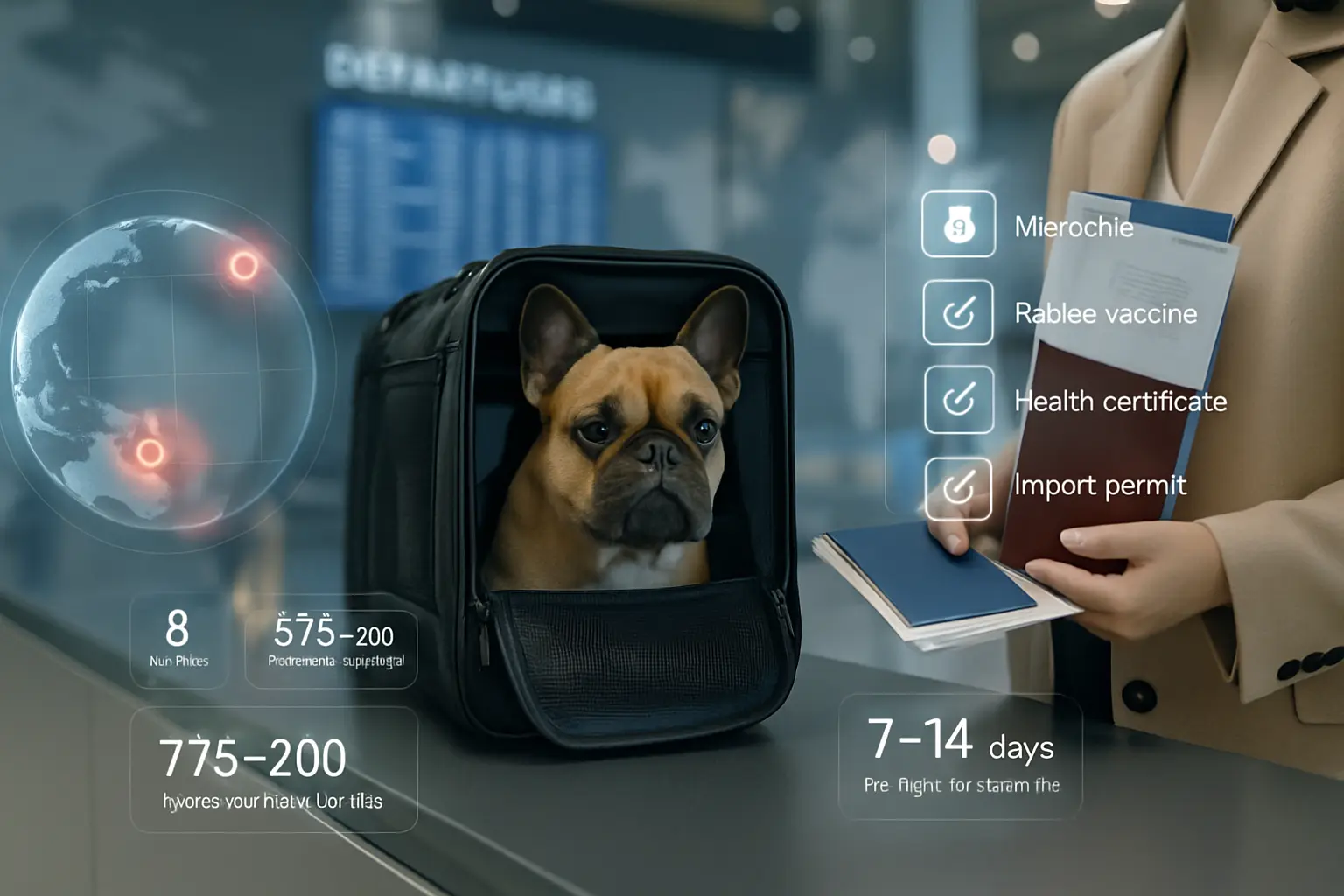
International travel with snub-nosed (brachycephalic) dogs attracts more rules than most pets. Many countries combine public health, biosecurity and animal welfare standards into restrictions that affect whether a flat-faced dog may fly in cabin. Airlines often add carrier-level bans or require a documented veterinary fitness-to-fly assessment for these breeds. Travelers whose itinerary includes destinations with strict entry rules must confirm both the airline and the destination requirements well before booking.
Some destinations impose quarantine or outright bans on certain breeds or on in-cabin arrival because of heat and respiratory risk. When an in-cabin option is impossible, practical workarounds include arranging climate-controlled cargo that meets IATA Live Animal Regulations, using a professional pet relocation company, or choosing a different routing or destination with friendlier rules. For general guidance about which dog types commonly travel by air and how carriers categorize them, see Dogs you can take on a plane.
Always verify embassy and official government sources for the destination country. A single missed requirement can trigger denial of entry, quarantine, or costly return transport. Maintain up-to-date copies of vaccination records, microchip data and import permits to smooth the process.
Countries that commonly prohibit in-cabin pets and practical workarounds
Countries with stringent biosecurity or welfare rules often limit in-cabin travel for brachycephalic breeds. Australia and New Zealand require detailed import processes and sometimes quarantine. Several Middle Eastern and Southeast Asian authorities enforce strict heat-season or breed-specific restrictions. Rather than assume permissibility, travelers should check destination animal import pages and airline policy pages.
Practical workarounds reduce risk and administrative headaches. First, consider alternate entry points or nearby countries with less restrictive pet rules, then arrange ground transfer. Second, hire a registered pet shipper to coordinate permits, veterinary checks, and approved transport containers. Third, select airlines that publish explicit brachycephalic policies and conditional acceptance rather than blanket bans.
When cargo is the only option, insist on climate control, limited transit time, and a direct or single-stop itinerary. For examples of carrier-level distinctions between in-cabin and cargo allowances, review summaries of airlines’ pet cargo policies at airlines that allow dogs in the cargo.
Import/export paperwork, transit rules and multi-carrier trips
Import and export paperwork forms the backbone of any international pet transfer. Required documents commonly include an ISO microchip certificate, a current rabies vaccination and certificate, a government or USDA/APHA health certificate issued within the required time window, and any country-specific import permits. Some nations require additional treatments, such as tapeworm or tick treatment, within a narrow timeframe before arrival.
Transit rules matter: some countries allow sterile transit without customs clearance, while others require full entry procedures during layovers. Each carrier on a multi-carrier itinerary enforces its own rules; the most restrictive policy often governs the trip. To avoid surprises, travelers should obtain written confirmations from every airline segment, including whether a through-checked bag or pet is permitted.
For multi-carrier trips, book a single itinerary when possible. Through-ticketing reduces paperwork repetition and prevents the need to reclaim and recheck the animal during a connection. Prepare duplicate physical and digital document sets, and schedule the pre-travel veterinary exam to match the strictest carrier or destination timing.
Tips to minimize connections and reduce paperwork complications
Minimizing connections significantly lowers the chance of paperwork failures and stress for snub-nosed dogs. Prioritize direct or single-stop flights on carriers that allow brachycephalic breeds in cabin or provide safe cargo alternatives. Early-morning flights reduce heat exposure risk and often avoid peak airport congestion.
Consolidate documentation tasks: obtain an import permit, a health certificate timed to arrival windows, and a vet fitness-to-fly letter during one visit. Keep certified translations if required, and carry both hard copies and digital scans. When an itinerary involves a transit country, confirm whether transit counts as entry for pet rules.
Use protective measures to reduce administrative burden: choose carriers offering through-checking, request that the airline note the pet on the PNR, and buy refundable tickets until all approvals arrive. If the route looks complex, engage a pet relocation specialist for a fixed-fee consultation. Before finalizing travel, contact the airline and the destination agency to reconfirm requirements and prevent last-minute denials.
Safe alternatives when commercial airlines won’t accept your dog
When a carrier declines a snub‑nosed dog, owners should prioritize options that reduce respiratory risk and stress. Driving offers the most control: it allows frequent stops, regulated cabin temperature, and familiar bedding. For longer distances, scheduled overnight ferries often permit pets in dedicated areas or in-vehicle cabins, which lowers pressure‑related risks compared with cargo holds. Trains can work for short- to mid-range trips when the operator allows pets under seats or in designated carriages; they eliminate pressurized‑cargo concerns and shorten total travel time.
Each option carries paperwork needs: vaccination records, current health certificates, and some routes require government ID or pet passports. Travel time, cost, and the dog’s medical history determine the best choice. For practical tips on prepping a dog for ground travel and choosing gear, see essential dog travel tips and gear for road trips. Owners should weigh trip duration, weather, and the dog’s tolerance for confinement before deciding.
Pet-focused charters and private/semi-private dog flights (what to expect)
Pet‑focused charters tailor services to companion animals and often avoid the restrictions that commercial cabins impose. Operators commonly offer private-cabin access or dedicated pet‑only flights where animals travel in the same pressurized space as passengers. Expect stricter booking windows, mandatory vet checks, and approved crates that meet IATA or operator standards.
Costs vary widely. Domestic semi‑private flights can start around a few hundred dollars per pet, while fully private charters typically run into the thousands. Additional fees cover ground handling, special staffing, and expedited paperwork. Charters can reduce the risk of heat or breathing issues by controlling cabin conditions and minimizing transfers.
Before booking, verify the operator’s insurance, read recent customer reviews, and request a full itinerary that lists transfer points. If the goal is to avoid cargo holds, owners should compare charter terms with commercial cargo policies, such as those summarized in airlines that allow dogs in the cargo, to confirm the charter offers a meaningful advantage. Contact two or three operators for quotes and ask about emergency protocols.
Professional pet relocation services: scope, costs and vetting providers
Professional pet relocators manage door‑to‑door moves, paperwork, and travel logistics. Their services include veterinary coordination, crate procurement, airline liaison, customs clearance, and ground transport. For domestic moves, basic packages often start under $1,000. International relocations commonly begin in the low thousands and can exceed $5,000 depending on distance and required permits.
To vet providers, confirm memberships in industry bodies such as IPATA, request proof of liability insurance, and ask for three recent references with similar routes. Verify they coordinate with accredited vets for preflight certificates and understand breed‑specific risks for brachycephalic dogs. Review their crisis plan for flight delays or quarantine holds, and demand transparent breakdowns of fees.
Relocators often supply or recommend compliant crates and advise on acclimation. Owners can learn crate-securing best practices from guides like how to secure a dog crate in car. Request written guarantees about health checks and refunds before signing. A short call with a candidate provider typically reveals reliability and attention to breed‑specific needs.
Ground, ferry and train options — pros, cons and when they make sense
Ground, ferry and train travel suit different risk profiles and trip lengths. Driving gives maximum control, ideal for dogs with known respiratory or anxiety issues. Ferries work well for coastal or island routes; many allow pets in-vehicle or in specific cabins, which reduces pressure and temperature risks compared with air travel.
Trains offer a middle ground: they reduce overall stress from transfers and maintain normal cabin pressure. However, train rules vary—some permit only small pets under seats, while others allow larger animals in carriers. Trains are best for regional moves where travel time stays reasonable.
Cons include longer transit times and unpredictable stops, which can increase stress for dogs prone to panting. Border crossings on ferries or trains still require documentation, and some operators limit breeds. For detailed tips on taking a dog by rail and planning pet‑friendly train travel, consult traveling with your dog by train: tips and tricks. Choose ground or sea when minimizing pressure changes and maximizing control matters most.
Gear, day-of checklist and backup plan
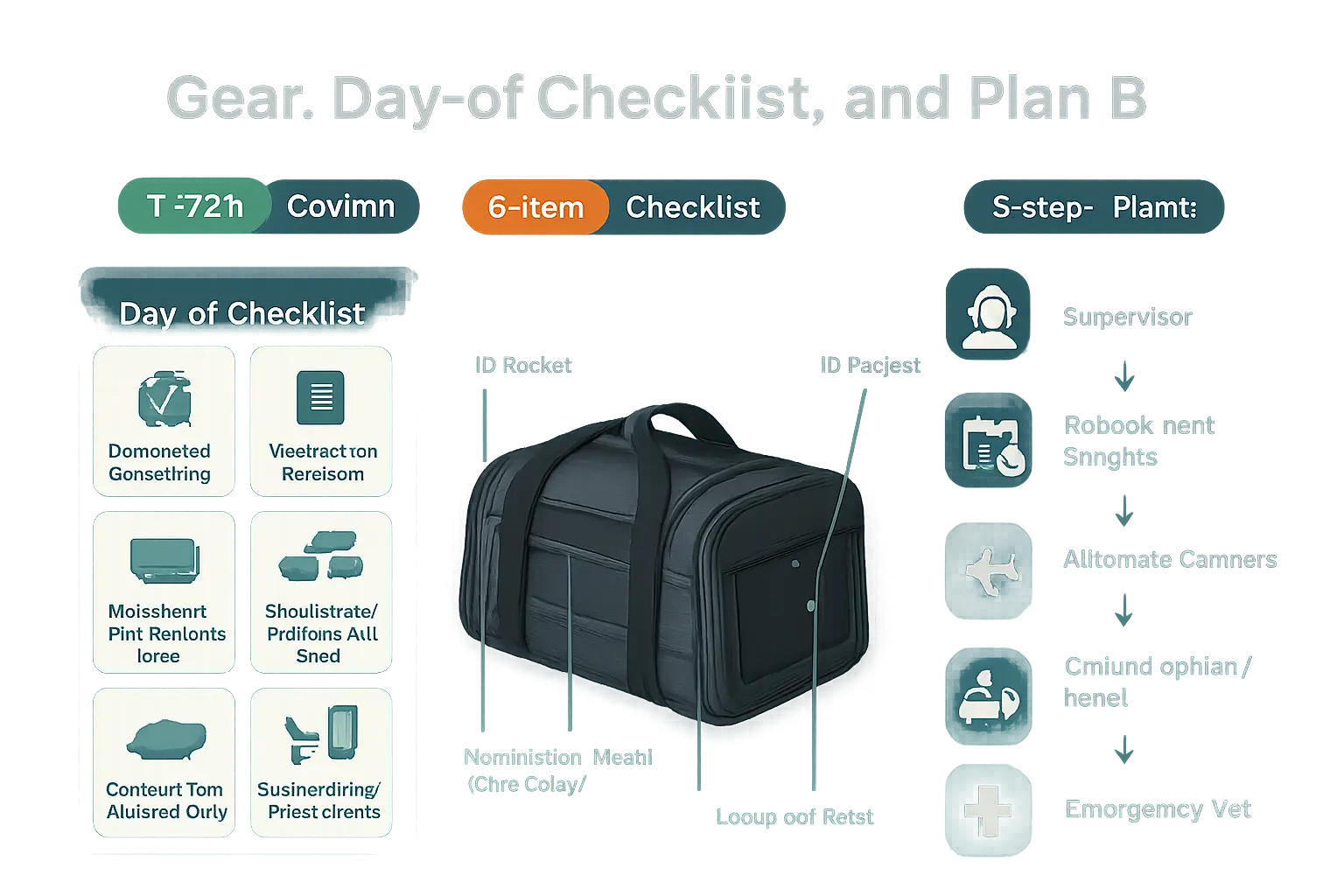
A concise, prioritized gear list keeps snub‑nosed dogs safe and compliant on travel days. Pack a soft‑sided carrier that meets the airline’s under‑seat dimensions, absorbent pads, a collapsible water bowl, and a lightweight leash. Confirm the airline’s brachycephalic breed policy, the flight temperature limits, and any paperwork or health‑certificate deadlines at least 72 hours before departure.
Day‑of checklist (quick):
- Carrier dimensions confirmed and labeled
- Up‑to‑date vaccination records and any required certificates
- Absorbent pad and spare towel
- Small bottle of water and collapsible bowl
- Comfort item (familiar blanket or toy)
- Seat assignment confirmed and gate phone number saved
Monitor weather and flight timing; brachycephalic dogs tolerate heat poorly. If flight cancellation or pet refusal occurs, the backup plan should include alternate carriers, next available flights, and an emergency vet contact. For broader gear guidance on pet travel, consult essential dog travel tips and gear for road trips. CTA: save digital and printed copies of all pet documents to a single folder on a phone.
Carrier features cheat‑sheet (expandable, ventilated, leak‑proof, ID pocket)
Choose a carrier that matches airline rules and the dog’s comfort needs. Prioritize ventilation, a secure closure system, and an expandable panel only if airlines allow extra width under the seat. Soft‑sided carriers generally pass under seats more easily and compress slightly during boarding. Hard‑sided crates rarely qualify for cabin use, so verify before buying.
Must‑have features:
- Ventilation: Mesh panels on three sides for airflow
- Leak‑proof base: Waterproof liner or removable tray
- Secure openings: Dual zippers with lock options and top‑entry access
- ID pocket: External sleeve for paperwork and a visible name tag
- Compression fit: Slightly flexible sides to fit under seat without crowding
Measure the airline’s under‑seat limit and the dog while sitting. Test the carrier at home with a short crate session and a familiar blanket. For details on sturdy travel carriers that suit vehicle and plane use, see the review of best dog crates for car travel in 2023. Avoid novelty carriers that lack ventilation or secure closures.
Cooling aids, calming tools, paperwork organizer and in‑cabin comfort items
Snub‑nosed breeds risk overheating and breathing issues. Prioritize passive cooling and gentle calming aids rather than sedatives. A frozen water bottle wrapped in a towel placed near but not against the dog helps lower ambient temperature. Thin cooling mats designed for pets also work if they fit inside the carrier without crowding.
Calming toolkit:
- Pheromone spray or wipe applied lightly to a blanket
- Anxiety wrap or snug towel for gentle pressure
- Portable white‑noise device or downloaded calming audio (low volume)
- Chew toy or lick mat with a small spread of high‑value food
Paperwork organizer should hold vaccination records, a health certificate, microchip details, and a digital photo of the dog. Keep hard copies in the carrier ID pocket and scanned copies on the phone. Pack small zip bags for treats and a disposable waste bag for emergencies. For non‑drug calming strategies and behavioral prep, consult 9 natural ways to remedy your dog’s travel anxiety. CTA: assemble the calming kit the night before travel.
Quick backup plan template: rebooking, alternate carriers and emergency vet contact
Prepare a short, actionable backup plan to use if airlines restrict cabin travel. Store this template on the phone and print one copy to place in the carrier’s ID pocket.
Backup plan template (editable):
- Immediate action: Calmly request to speak with a supervisor and note their name and reference number.
- Rebooking: Check next three flights on the same carrier and two alternative carriers that accept brachycephalic dogs in cabin.
- Alternate carriers to contact: List two airlines by name and reservation phone numbers.
- Ground options: Nearest pet‑friendly hotel and driving route estimations if rerouting by car is feasible.
- Emergency vet: Local 24‑hour clinic name, phone, and distance from the airport. Add the dog’s medical summary and current medications.
Include a short script to present to gate agents: a calm statement of the dog’s breed, health documentation, and a polite request for the next available option. For alternate carrier ideas that accept larger or restricted breeds, review airlines that permit large dogs in cabin at airlines that allow large dogs in cabin. CTA: save this template to the phone’s home screen for quick access.
Frequently asked questions owners search for
Owners of brachycephalic dogs frequently ask which carriers and routes allow small snub‑nosed breeds in cabin, and what risks to avoid. Airline rules vary by carrier, aircraft type and destination, so confirm policies before booking. For a broader overview of flight‑friendly breeds and seat‑space considerations, see dogs you can take on a plane.
Can pugs, French Bulldogs or Shih Tzus fly in the cabin?
Many airlines permit pugs, French bulldogs and Shih Tzus in cabin when the dog fits comfortably in an approved carrier under the seat. Restrictions often include weight and carrier size limits, age minimums and documentation. Some carriers restrict certain brachycephalic breeds entirely. Check the airline’s under‑seat dimensions and rules for in‑cabin pets before purchase. For carrier‑size guidance, consult dog breeds that fit under airplane seat.
Is cargo ever safe for brachycephalic breeds?
Cargo poses elevated risks for snub‑nosed dogs due to heat sensitivity and airway compromise. Many carriers either prohibit brachycephalic breeds from checked cargo or impose strict conditions. If cabin travel is unavailable, consider alternative transport or airlines with approved in‑cabin allowances. Review specific cargo policies and climate controls on the airline’s pet page before deciding. Related operational issues are covered in airlines that allow dogs in the cargo.
Should I sedate my snub‑nosed dog for travel?
Sedation carries higher risk for brachycephalic dogs because it can depress respiration. Vets rarely recommend routine sedatives for flights. Safer strategies include a pretrip vet exam, acclimating the dog to its carrier, and prescribed mild anxiolytics only when a veterinarian approves them. Natural calming options may help; see 9 natural ways to remedy your dog’s travel anxiety. Always consult a veterinarian first.
Typical pet fees and when charges vary (international/charter options)
Domestic in‑cabin fees commonly range from about $75 to $200 per flight leg. International charges rise and may include crate inspection, health certificate processing, and import permits. Fees depend on carrier, route, and whether the animal travels as carry‑on, checked or on a private/charter flight. Private charters usually bill differently and may accept special accommodations. For examples of carrier fee policies and cabin rules, review airlines that allow cats in cabin.
Summary
This guide names eight airlines that accept snub-nosed (brachycephalic) dogs in the cabin—Delta, United, American, JetBlue, Alaska, Air Canada, KLM, and Aeroméxico—and explains the fees, carrier rules, and route exceptions travelers should expect. Across carriers, the pattern holds: in-cabin is typically allowed when the pet fits safely under the seat, while cargo is largely banned for flat-faced breeds due to respiratory risk.
It also outlines how to prepare: reserve the pet spot early, size the carrier to the aircraft’s under-seat limits, secure current veterinary documents, and follow practical risk-reduction steps on flight day. For itineraries where airlines won’t accept these breeds, the post walks through safe alternatives, including ground travel, charters, and professional relocation.
Key Takeaways
- Eligible airlines: Delta, United, American, JetBlue, Alaska, Air Canada, KLM, and Aeroméxico allow snub-nosed dogs in cabin when carriers meet under-seat requirements; most prohibit these breeds in cargo.
- Fees and space are limited: Expect a per-segment in-cabin pet fee (often about $75–$200 domestically); reserve early because flights cap the number of cabin pets.
- Carrier fit is crucial: Soft-sided carriers that compress to the aircraft’s under-seat dimensions work best; combined pet-plus-carrier weight limits and acceptable seats vary by aircraft.
- Paperwork and health: Schedule a vet exam 7–14 days before departure, bring vaccination records and a fitness-to-fly note, and avoid heavy sedation unless a veterinarian specifically approves it.
- Risk reduction on travel day: Choose nonstop or single-stop routes, avoid heat extremes, arrive early, and monitor breathing; ask crew before briefly unzipping for airflow.
- Have a Plan B: If a flight denies boarding, use a prepared rebooking script, consider alternate carriers, or pivot to ground travel, charters, or a pet relocation service.
FAQ
-
What airlines currently allow snub-nosed dogs in the cabin?
Delta, United, American, JetBlue, Alaska, Air Canada, KLM, and Aeroméxico accept brachycephalic dogs in cabin when they meet carrier and size rules. Always confirm aircraft type, route exceptions, and pet caps before booking. -
How much do airlines charge for in-cabin pets, and when do fees change?
Domestic fees commonly range about $75–$200 per flight leg, with higher or additional charges on international segments. Fees vary by carrier, route, and aircraft; verify the exact amount during reservation. -
What carrier size and weight limits apply for snub-nosed dogs?
The carrier must fit fully under the seat, and most airlines prefer soft-sided models; combined pet-and-carrier weight limits depend on the aircraft. Check the airline’s under-seat dimensions for the specific flight. -
Why won’t most airlines accept brachycephalic breeds in cargo?
Flat-faced breeds face higher risks of heat stress and airway compromise, and cargo environments limit real-time monitoring. To protect welfare and reduce liability, many carriers ban these breeds from checked or manifest cargo. -
How can owners improve flight-day safety for a snub-nosed dog?
Book nonstop flights, avoid temperature extremes, acclimate the dog to the carrier, feed a light meal 3–4 hours before departure, and bring cooling aids; use medication only with veterinary guidance and arrive early for screening.

